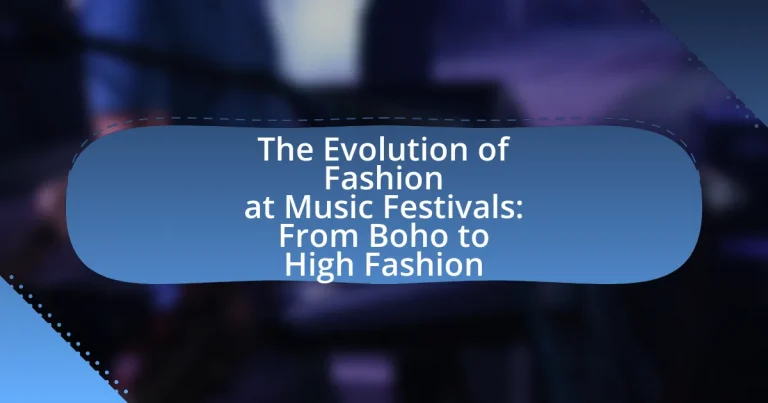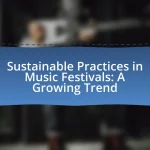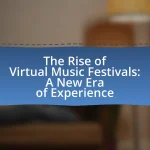The article examines the evolution of fashion at music festivals, tracing its journey from the bohemian styles of the 1960s and 1970s to the integration of high fashion elements in contemporary festival attire. It highlights key fashion trends over the decades, including the influence of counterculture movements, celebrity culture, and social media on festival fashion. The piece also discusses the significance of Boho fashion, the role of music festivals in shaping global fashion trends, and the increasing presence of luxury brands at these events. Additionally, it explores future trends in festival fashion, emphasizing sustainability, technology, and the impact of social media on style choices among festival-goers.
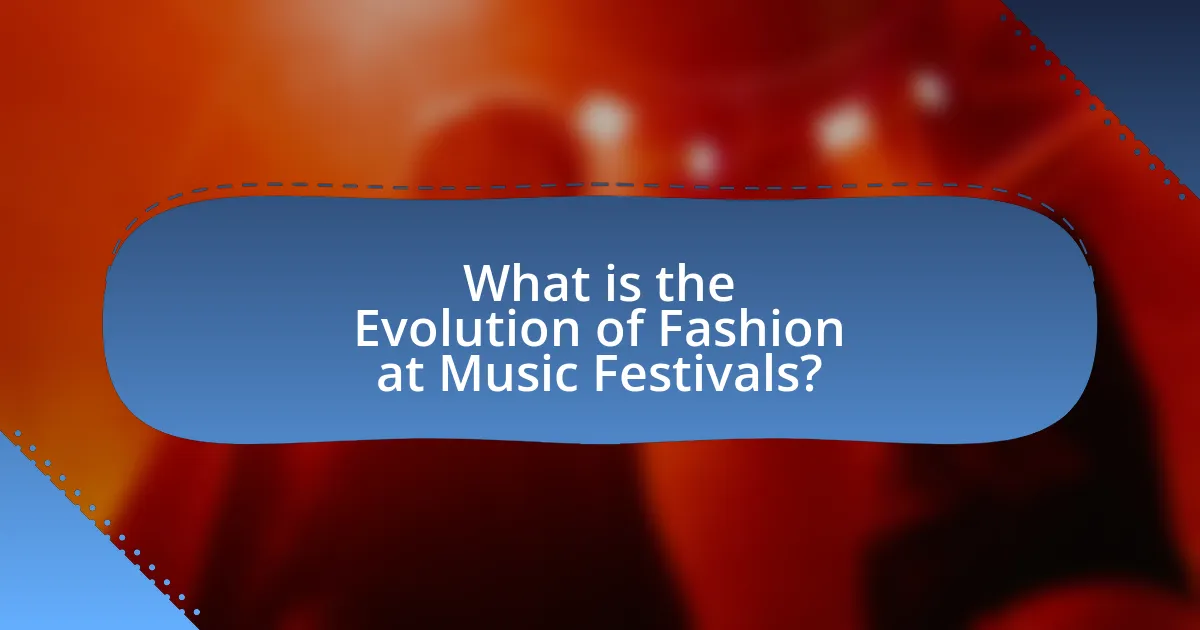
What is the Evolution of Fashion at Music Festivals?
The evolution of fashion at music festivals has transitioned from the bohemian styles of the 1960s and 1970s to the incorporation of high fashion elements in contemporary festival attire. Initially, music festival fashion was characterized by free-spirited, eclectic styles, often featuring flowing garments, floral patterns, and handmade accessories, reflecting the counterculture movements of the time. As festivals gained popularity, particularly in the 2000s, fashion began to evolve, influenced by celebrity culture and social media, leading to the emergence of more curated and designer-driven looks.
By the 2010s, high fashion brands started collaborating with festivals, resulting in a blend of luxury and casual wear, exemplified by events like Coachella, where attendees often showcase designer outfits alongside traditional festival attire. This shift highlights a significant change in the perception of festival fashion, transforming it into a platform for self-expression and fashion statements, supported by the rise of influencers and the visibility of festival culture in mainstream media.
How has fashion at music festivals changed over the decades?
Fashion at music festivals has evolved significantly over the decades, transitioning from the bohemian styles of the 1960s and 1970s to the high-fashion influences seen in recent years. In the early days, festival-goers often wore loose-fitting, colorful clothing, reflecting the counterculture movements of the time, with iconic events like Woodstock showcasing tie-dye, fringe, and flower crowns. By the 1980s and 1990s, grunge and rave cultures introduced darker palettes, oversized silhouettes, and eclectic accessories, influenced by bands and electronic music scenes.
In the 2000s, fashion began to incorporate more mainstream trends, with brands targeting festival audiences, leading to the rise of fast fashion. The 2010s marked a shift towards high fashion, with designers collaborating with festivals and celebrities influencing styles, resulting in more polished and curated looks. This evolution reflects broader societal changes, including the rise of social media, which has amplified the visibility of festival fashion and encouraged attendees to showcase their outfits online.
What were the key fashion trends in the early music festivals?
Key fashion trends in early music festivals included bohemian styles, tie-dye clothing, and denim. These trends were characterized by flowing garments, vibrant colors, and a relaxed aesthetic that reflected the counterculture movements of the 1960s and 1970s. The Woodstock Festival in 1969 exemplified this with attendees wearing bell-bottom jeans, fringe vests, and flower crowns, symbolizing peace and love. Additionally, the use of vintage and handmade items became popular, emphasizing individuality and self-expression among festival-goers.
How did the 1970s and 1980s influence festival fashion?
The 1970s and 1980s significantly influenced festival fashion by introducing vibrant colors, eclectic styles, and a blend of cultural influences. The 1970s saw the rise of bohemian aesthetics characterized by flowing fabrics, fringe, and ethnic prints, largely inspired by the counterculture movement and festivals like Woodstock in 1969. This era emphasized individuality and self-expression, leading to the popularity of items such as bell-bottoms, maxi dresses, and platform shoes.
In the 1980s, festival fashion evolved further with the incorporation of bold patterns, neon colors, and the influence of punk and new wave music. Iconic festivals like Glastonbury showcased this shift, where attendees embraced more daring styles, including leather jackets, graphic tees, and accessories like studded belts. The emergence of MTV also played a crucial role in shaping fashion trends, as music videos showcased artists in distinctive outfits that fans emulated at festivals.
Overall, the 1970s and 1980s laid the groundwork for the diverse and expressive festival fashion seen today, blending cultural elements and personal style into a vibrant tapestry of self-expression.
Why is the concept of ‘Boho’ significant in festival fashion?
The concept of ‘Boho’ is significant in festival fashion because it embodies a free-spirited, eclectic style that resonates with the values of self-expression and individuality prevalent at music festivals. This aesthetic, characterized by flowing fabrics, vibrant patterns, and layered accessories, emerged in the 1960s and 1970s, aligning with the counterculture movements of those decades. The popularity of Boho fashion at festivals like Coachella and Glastonbury reflects a cultural shift towards embracing non-conformity and artistic expression, making it a staple in festival attire. Its significance is further underscored by the fact that many festival-goers adopt Boho styles to create a sense of community and shared identity, enhancing the overall festival experience.
What elements define Boho fashion at music festivals?
Boho fashion at music festivals is defined by its eclectic mix of vintage and modern styles, characterized by flowing silhouettes, earthy colors, and a focus on comfort. Key elements include maxi dresses, fringe details, layered accessories, and natural fabrics like cotton and linen. This style often incorporates ethnic prints, crochet, and bohemian-inspired jewelry, reflecting a free-spirited aesthetic. The popularity of Boho fashion at festivals can be traced back to the 1960s and 1970s counterculture movements, which emphasized individuality and artistic expression, making it a staple in festival attire today.
How did Boho fashion reflect the culture of music festivals?
Boho fashion reflected the culture of music festivals by embodying a free-spirited, eclectic aesthetic that resonated with the values of individuality and self-expression prevalent in festival environments. This style, characterized by flowing fabrics, vibrant patterns, and layered accessories, emerged prominently in the 1960s and 1970s alongside the rise of counterculture movements and music festivals like Woodstock. The emphasis on comfort and creativity in Boho fashion allowed festival-goers to express their identities and connect with the communal atmosphere of these events, reinforcing the idea of music festivals as spaces for artistic freedom and social connection.
What role do music festivals play in the fashion industry?
Music festivals serve as significant platforms for fashion trends, influencing styles and consumer behavior within the fashion industry. These events showcase diverse fashion expressions, often blending high fashion with streetwear, which leads to increased visibility for designers and brands. For instance, festivals like Coachella have become synonymous with bohemian styles, prompting major fashion retailers to create festival-inspired collections that cater to this audience. The impact is measurable; a report by Edited in 2019 indicated that festival fashion sales surged by 30% during peak festival seasons, highlighting the economic influence of these events on the fashion market.
How do designers and brands leverage music festivals for marketing?
Designers and brands leverage music festivals for marketing by creating immersive experiences that engage festival-goers and enhance brand visibility. These events provide a platform for brands to showcase their latest collections through pop-up shops, collaborations with artists, and sponsorships, allowing them to reach a targeted audience that aligns with their brand identity. For instance, Coachella has become a hotspot for fashion brands, with many using influencer partnerships to amplify their reach; in 2019, over 1,000 influencers attended the festival, significantly increasing brand exposure. Additionally, brands often utilize social media campaigns tied to festival experiences, encouraging attendees to share their festival looks, which further promotes brand engagement and visibility.
What impact do music festivals have on fashion trends globally?
Music festivals significantly influence global fashion trends by serving as platforms for innovative styles and cultural expression. These events showcase diverse fashion choices, often blending high fashion with streetwear and bohemian aesthetics, which in turn inspires mainstream fashion designers and retailers. For instance, the Coachella Valley Music and Arts Festival has become a trendsetter, with its attendees often seen wearing unique outfits that later appear in major fashion collections. The visibility of festival fashion on social media amplifies this impact, as influencers and attendees share their looks, leading to widespread adoption of similar styles. This phenomenon is supported by data indicating that fashion brands frequently reference festival styles in their seasonal collections, demonstrating the direct correlation between music festivals and evolving fashion trends.
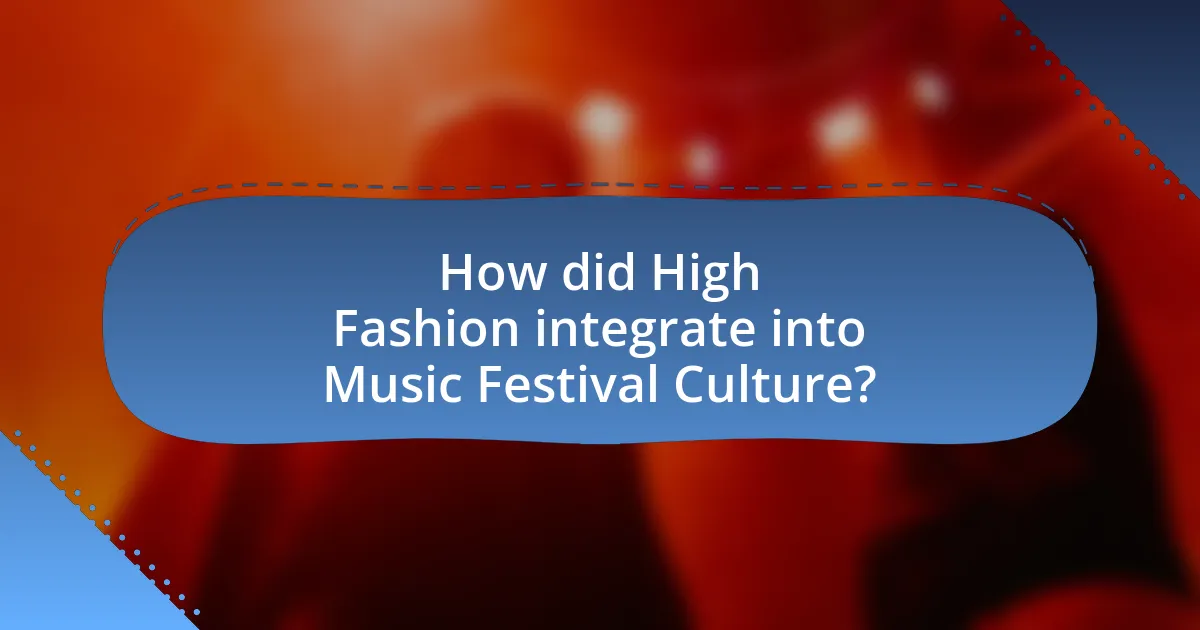
How did High Fashion integrate into Music Festival Culture?
High fashion integrated into music festival culture through collaborations between luxury brands and festival organizers, creating exclusive collections that resonate with the festival aesthetic. Notable examples include the partnership between Coachella and brands like H&M and the emergence of designer streetwear labels, which have made high-end fashion accessible to festival-goers. This shift is evidenced by the increasing presence of celebrities and influencers at festivals, often showcasing high fashion looks, which has further popularized the trend. Additionally, the rise of social media platforms has amplified the visibility of high fashion at festivals, allowing for real-time sharing of fashion-forward outfits, thus solidifying the connection between high fashion and music festival culture.
What are the characteristics of High Fashion at music festivals?
High fashion at music festivals is characterized by bold, avant-garde designs that prioritize individuality and artistic expression. This fashion trend often features high-quality materials, intricate detailing, and unique silhouettes that stand out in a crowd. Additionally, high fashion at these events incorporates elements such as statement accessories, vibrant colors, and innovative layering techniques, reflecting the festival’s eclectic atmosphere. The rise of social media has further amplified this trend, as attendees seek to showcase their distinctive styles online, leading to a fusion of runway aesthetics with festival culture.
How do luxury brands approach festival fashion?
Luxury brands approach festival fashion by integrating high-end aesthetics with practical, festival-ready designs. They often create exclusive collections that reflect the vibrant, eclectic spirit of music festivals while maintaining their signature luxury appeal. For instance, brands like Gucci and Balenciaga have launched capsule collections specifically tailored for festival-goers, featuring bold prints, unique silhouettes, and high-quality materials. This strategy not only enhances brand visibility at major events but also caters to a growing consumer demand for luxury items that embody both style and functionality in a festival setting.
What are some notable collaborations between designers and festivals?
Notable collaborations between designers and festivals include the partnership between H&M and Coachella, which has produced exclusive festival-inspired collections since 2012, making high fashion accessible to festival-goers. Another significant collaboration is between designer Jeremy Scott and the music festival Lollapalooza, where Scott has showcased his vibrant designs on stage and in promotional materials, enhancing the festival’s visual identity. Additionally, the collaboration between Gucci and the 2021 Met Gala, themed “In America: A Lexicon of Fashion,” featured designs that resonated with the festival’s artistic expression, showcasing the intersection of high fashion and music culture. These collaborations illustrate how designers leverage festivals to reach broader audiences while enhancing the festival experience with unique fashion statements.
Why has High Fashion become popular at music festivals?
High fashion has become popular at music festivals due to the intersection of celebrity influence, social media visibility, and the desire for self-expression among attendees. Celebrities and influencers often showcase high-end designer outfits at these events, creating a trend that fans aspire to emulate. Social media platforms amplify this phenomenon, allowing festival-goers to share their fashion choices widely, which in turn encourages others to adopt similar styles. Additionally, the festival environment provides a unique space for individuals to express their creativity and personal style, making high fashion an appealing choice. This shift is supported by the increasing presence of luxury brands at festivals, further legitimizing high fashion as a staple in the festival scene.
What social factors contribute to the rise of High Fashion in this context?
The rise of High Fashion in the context of music festivals is primarily driven by the increasing influence of social media and celebrity culture. Social media platforms like Instagram and TikTok enable rapid dissemination of fashion trends, allowing festival-goers to showcase their outfits and gain visibility, which in turn encourages brands to cater to this audience. Additionally, the presence of celebrities and influencers at music festivals amplifies the desirability of High Fashion, as their choices often set trends that fans aspire to emulate. This phenomenon is supported by data showing that 70% of consumers are influenced by social media when making fashion purchases, highlighting the significant role of these platforms in shaping fashion preferences.
How do festival-goers respond to High Fashion trends?
Festival-goers often embrace High Fashion trends by incorporating designer pieces into their festival outfits, reflecting a blend of personal style and current fashion influences. This response is evident in the increasing presence of luxury brands at music festivals, where attendees showcase high-end clothing and accessories, signaling a shift from traditional bohemian styles to more curated, fashion-forward looks. For instance, events like Coachella have seen collaborations between major fashion houses and festival-goers, leading to a rise in visibility for High Fashion within the festival culture.
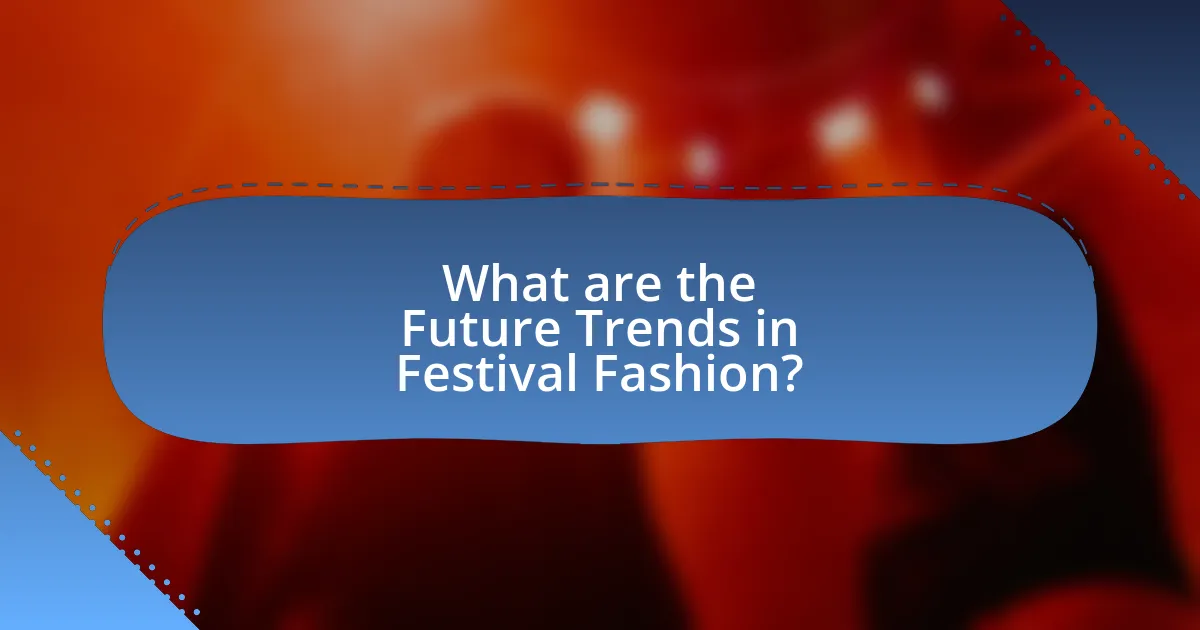
What are the Future Trends in Festival Fashion?
Future trends in festival fashion include a shift towards sustainable materials, increased use of technology in clothing, and a blend of high fashion with streetwear aesthetics. Sustainable fashion is gaining traction as consumers become more environmentally conscious, leading brands to adopt eco-friendly fabrics and production methods. Additionally, wearable technology, such as smart fabrics that can change color or patterns, is expected to become more prevalent, enhancing the interactive experience of festival-goers. The fusion of high fashion with casual streetwear reflects a growing desire for comfort without sacrificing style, as seen in collaborations between luxury brands and streetwear labels. These trends indicate a dynamic evolution in festival fashion that prioritizes sustainability, innovation, and personal expression.
How is sustainability influencing fashion choices at music festivals?
Sustainability is significantly influencing fashion choices at music festivals by driving attendees to prioritize eco-friendly materials and ethical brands. Many festival-goers now seek clothing made from organic, recycled, or upcycled materials, reflecting a growing awareness of environmental issues. For instance, a survey by Eventbrite found that 70% of festival attendees prefer brands that demonstrate a commitment to sustainability. This shift is also evident in the rise of rental services and second-hand shopping, as participants aim to reduce waste and promote circular fashion.
What sustainable practices are being adopted by festival-goers?
Festival-goers are adopting various sustainable practices, including using reusable water bottles, opting for eco-friendly fashion, and participating in recycling initiatives. These actions reflect a growing awareness of environmental issues, with many attendees choosing to wear clothing made from organic or recycled materials. Additionally, festivals are increasingly providing recycling stations and encouraging waste reduction, which aligns with the broader trend of sustainability in the music festival culture.
How are brands responding to the demand for eco-friendly fashion?
Brands are increasingly adopting sustainable practices to meet the rising demand for eco-friendly fashion. Many companies are incorporating organic materials, such as organic cotton and recycled polyester, into their collections, which reduces environmental impact. For instance, major brands like H&M and Adidas have launched lines that utilize recycled materials, demonstrating a commitment to sustainability. Additionally, brands are implementing transparent supply chains and ethical labor practices, which resonate with environmentally conscious consumers. According to a 2021 McKinsey report, 67% of consumers consider sustainability when making fashion purchases, highlighting the importance of eco-friendly initiatives in driving brand loyalty and sales.
What innovations are shaping the future of festival fashion?
Innovations shaping the future of festival fashion include sustainable materials, technology integration, and customization options. Sustainable materials, such as recycled fabrics and biodegradable textiles, are increasingly being adopted by brands to reduce environmental impact, reflecting a growing consumer demand for eco-friendly fashion. Technology integration, including augmented reality (AR) and wearable tech, allows festival-goers to enhance their experience through interactive clothing and accessories. Customization options, such as on-site tailoring and personalized designs, enable attendees to express their individuality, aligning with the trend towards unique, self-expressive fashion. These innovations are supported by industry reports indicating a significant shift towards sustainability and personalization in fashion, particularly within the festival context.
How is technology impacting fashion at music festivals?
Technology is significantly impacting fashion at music festivals by enabling innovative designs, enhancing personalization, and facilitating sustainable practices. Wearable technology, such as smart fabrics and LED-integrated clothing, allows festival-goers to express their individuality while also adapting to environmental conditions. For instance, brands like CuteCircuit have created garments that change color or display messages based on the wearer’s mood or surroundings. Additionally, advancements in 3D printing and digital fashion design are streamlining the production process, allowing for rapid prototyping and customization, which aligns with the fast-paced nature of festival culture. Furthermore, technology promotes sustainability by enabling brands to utilize eco-friendly materials and reduce waste through on-demand production methods. This shift towards tech-driven fashion not only enhances the aesthetic experience at festivals but also aligns with the growing demand for environmentally conscious practices in the fashion industry.
What role does social media play in evolving festival fashion trends?
Social media significantly influences the evolution of festival fashion trends by providing a platform for instant sharing and visibility of styles. Platforms like Instagram and TikTok allow festival-goers, influencers, and brands to showcase outfits in real-time, creating viral trends that can spread rapidly. For instance, the rise of the “Coachella look” has been largely driven by social media, where specific styles, such as bohemian aesthetics or high-fashion ensembles, gain popularity through user-generated content and influencer endorsements. According to a study by the Fashion Institute of Technology, 70% of consumers reported that social media influences their fashion choices, highlighting its critical role in shaping festival fashion trends.
What tips can festival-goers follow to blend comfort and style?
Festival-goers can blend comfort and style by choosing breathable fabrics, such as cotton or linen, and incorporating versatile layering pieces. Breathable fabrics help regulate body temperature, ensuring comfort during long hours outdoors, while layering allows for adaptability to changing weather conditions. Additionally, selecting stylish yet functional footwear, like supportive sandals or sneakers, enhances comfort without sacrificing aesthetics. Accessories, such as wide-brimmed hats and statement sunglasses, can elevate an outfit while providing sun protection. This approach aligns with the trend of merging practicality with fashion, as seen in the evolution of festival attire from purely bohemian styles to more curated, high-fashion looks.
